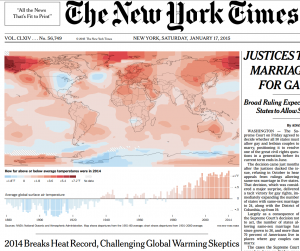
a front page section of the New York Times showing how far above or below average temperatures were in 2014, compared to other years.
The hot topic of climate change has been filling the news lately. As our President and many members of the GOP deny the science behind it, carrying snowballs into the Senate it can be hard to trust the things one reads on this subject. While members of the scientific community are much more aware of the threat that climate change poses to many peoples livelihoods, the general public is forced to sift through articles with fake science, or twisted facts.
In searching for a publication on climate change to evaluate, I found myself more drawn to things that the general public would have access to, as opposed to scientific journals or websites filled with jargon. This lead me to the New York Times, which is still a left leaning publication. One of the writers for the NYT just last week published what would be a seemingly helpful article on climate change: “Climate Change is Complex. We’ve got Answers to Your Questions. This article outlines answers to seventeen climate questions, in a few simple paragraphs.
Reading the article, I still felt some bias within my own analysis. I knew the New York Times was left leaning, and they were highlighting the importance of climate change, and its impacts. It became hard to separate my own views on climate change from what I was reading. Nevertheless, I began my detective work. My science based background proved to be helpful in assessing the credibility of this article. I looked for what websites were cited through the data restated in the article, considered what kind of audience the article was made for, and whether or not the sources used were both clearly outlined and peer reviewed.
I also attempted to assess the credibility of the author, with the understanding that this article was not meant for the scientific community, or to be used for research or implementing policies. It was an article meant to highlight some of the queries that people may have about climate change, to increase general awareness of the issues in an easy to understand way. Justin Gillis, the author of the article exclusively writes about the science of global climate change, and policy implications. His articles have been reviewed by Climate Feedback, where scientists review journalists articles covering climate change.
The overall reviews of his articles explain that he generally explains the research well, and all of Justin Gillis’s articles analyzed by these climate scientists show high “scientific credibility.” He seems to be reputable for a journalist analyzing hard science, although the scientists felt that he could have been more precise with some of his summaries of scientific research. The New York Times is off to a relatively good start with a credible author who has been under review by several climate scientists.
One problem I ran into with assessing the validity of the article, is that some of the facts about climate change were not sited with hyperlinks. I thought that I would find the sources he used at the bottom of the article, but could not find anything that would show where he found the facts such as: “As of early 2017, the Earth had warmed by roughly 2 degrees Fahrenheit (more than 1 degree Celsius) since 1880, when records began at a global scale.” This data rich statement had no citation attached to it, and it seems that there might be fluctuations in these numbers depending on who was researching this.
At first, I was pleased as the first of the hyperlinks embedded into the article lead me to a scholarly journal article from The Philosophical Magazine and Journal of Science, which has been peer reviewed.
However, I found myself almost immediately disheartened as all of the other hyperlinks in the article, showing where Gillis got his information lead me to other articles published in the New York Times. Every click redirected me back to another journalist reviewing a scientific matter, but I could not find where these journalists were getting their scientific information from. I dove into the reinforcing feedback loop of New York Times articles and chose what seemed to be a fact based in hard science explaining that “15 to 20 feet of sea level rise is inevitable” and will result in floods for many cities.
This hyperlink took me to a New York Times article by Tatiana Schlossberg, “Rising Sea Levels May Disrupt Lives of Millions, Study Says.” Fortunately this article actually took me to a website other than the New York Times, however it still did not seem to be a scientific article, but rather a letter summarizing multiple scientific publications. There were an upwards of forty citations linked on this letter, and it did seem to be scientifically valid.
While I would not trust using the New York times for writing my own research, or really assessing climate facts I do think there is a level of credibility to the article and it is useful in getting the basic information out to the public.
Works Cited:
Gillis, Justin. “Climate Change Is Complex. We’ve Got Answers to Your Questions.” The New York Times, The New York Times Company, 19 Sept. 2017, Accessed 24 Sept. 2017.
“Justin Gillis articles analyzed.” Climate Feedback, Sierra Nevada Research Institute, 2017. Accessed 24 Sept. 2017.
Hauer, Mathew E., et al. “Millions projected to be at risk from sea-Level rise in the continental United States.” Nature Climate Change, vol. 6, no. 7, 2016, pp. 691–695.
Schlossberg, Tatiana. “Rising Sea Levels May Disrupt Lives of Millions, Study Says.” The New York Times, The New York Times Company, 14 Mar. 2016, Accessed 24 Sept. 2017.
